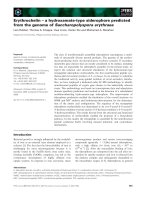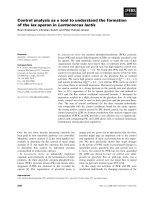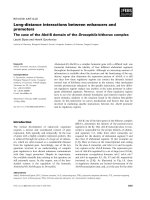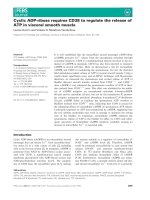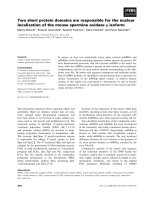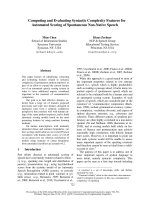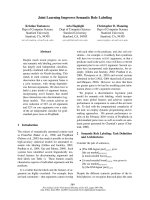Báo cáo khoa học: "TaqMan reverse transcription polymerase chain reaction for the detection of Japanese encephalitis virus" pot
Bạn đang xem bản rút gọn của tài liệu. Xem và tải ngay bản đầy đủ của tài liệu tại đây (748.67 KB, 7 trang )
-2851$/ 2)
9H W H U L Q D U \
6FLHQFH
J. Vet. Sci.
(2004),
/
5
(4), 345–351
TaqMan reverse transcription polymerase chain reaction for the detection
of Japanese encephalitis virus
Dong-Kun Yang
1,
*, Chang-Hee Kweon
1
, Byoung-Han Kim
1
, Seong-In Lim
1
, Seong-Hee Kim
1
,
Jun-Hun Kwon
1
, Hong-Ryul Han
2
1
National Veterinary Research and Quarantine Service, Ministry of Agriculture and Forestry, Anyang 430-824, Korea
2
Department of Veterinary Internal Medicine, College of Veterinary Medicine, Seoul National University, Seoul 151-742, Korea
One step TaqMan reverse transcription polymerase
chain reaction (RT-PCR) using TaqMan probe was
developed for detection of Japanese encephalitis virus
(JEV). Real-time RT-PCR was optimized to quantify JEV
using the detection system (Rotor Gene 2000 detector)
and dual-labeled fluorogenic probes. The gene specific
labeled fluorogenic probe for the 3' non-translated region
(3' NTR) was used to detect JEV. When the specificity of
the assay using specific JEV primers was evaluated by
testing three different JEV strains, other swine viruses
and bovine viral diarrhea virus, no cross-reactions were
detected with non-JE reference viruses. A single tube
TaqMan assay was shown to be 10-fold more sensitive
than the conventional two-step RT-PCR method.
Detection limits of two step and real-time RT-PCR for
JEV were 112 TCID
50
/ml and 11.2 TCID
50
/ml, respectively.
Quantification of JEV was accomplished by a standard
curve plotting cycle threshold values (C
t
) versus infectivity
titer. Real-time RT-PCR assay using single tube method
could be used as a sensitive diagnostic test, and supplied
the results in real time for detection and quantification of
JEV. We could detect JEV RNA genome in plasma
samples of pigs inoculated with KV1899 strain at 2 days
post inoculation, but couldn’t in 41 fetus samples. This
assay was sensitive, specific, rapid and quantitative for the
detection of JEV from laboratory and field samples.
Key words:
Real-time RT-PCR, JEV, TaqMan, quantification
Introduction
Japanese encephalitis (JE) is a mosquito-borne viral
disease of animal that causes one of the major reproductive
disorders in swine industry. JEV has been implicated in
periodic outbreaks of encephalitis cases reported in different
countries of Asia in human [2]. JEV is a member of the
Flavivirus
genus in the
Flaviviridae
family with a positive
sense, and single stranded RNA viruses [2,6,27]. Experimental
infection of susceptible pregnant sow causes no clinical
signs in dams but results in infection of fetus in uterus and
subsequent abnormal farrowings: various numbers of
mummified fetus of different sizes, stillborn and weak
piglets with subcutaneous edema and hydrocephalus [13,24].
Mosquitoes of
Culex
are the major vectors involved in
transmission. Migrating birds such as night heron and cattle
egret are thought to be important in the dispersal of JEV to
new geographic areas [11]. Among domestic animals, pigs
are considered as a principal amplifying host. Consistent
development of viremia in pigs ensures a continued supply
of infected mosquitoes. It is not easy to control the
mosquitoes; therefore immunization policy of pigs with JEV
live vaccine has been applied before mosquitoes activate as
an applicable control and preventive measurement in Korea.
Several serologic tests, such as hemagglutination inhibition
(HI) test, enzyme-linked immunosorbent assay (ELISA),
serum neutralization technique, epitope blocking immunoassay
and dot enzyme immunoassay, have been used for detection
of antibody for JEV infection [3,5,13]. Nevertheless, some
of the above techniques require time to set up and are
complicate to apply for the diagnostic test. Although
isolation of the virus from samples is essential to make a
definitive diagnosis, recently RT-PCR has been used to
detect
flavivirus
genome in a rapid and specific test [10,15,
16,20,25]. Two-step RT-PCR assay requires agarose gel
analysis for the detection of amplicons after PCR cycling.
So, the assay is labor-intensive and has a very high risk of
contamination.
Recently, real-time RT-PCR technique has been used
extensively to detect amplicon that is amplified during the
PCR cycling in real time [1,12,19,23]. The development of
fluorogenic PCR utilizing 5'-3' nuclease activity of Taq
DNA polymerase made it possible to eliminate post PCR
processing such as visualization in agarose [9,26]. In
*Corresponding author
Tel: +82-31-467-1794; Fax: +82-31-467-1797
E-mail:
346 Dong Kun Yang
et al.
addition, the real-time RT-PCR technique is shown to give
good sensitivity and linear relationship between copy
number and cycle threshold (C
t
) values. The technique uses
oligonucleotide probes labeled with fluorescent dyes, a
reporter at the 5' end and a quencher at the 3' end to monitor
accumulation of PCR products [4].
In this study, a real-time RT-PCR assay with TaqMan
probe was investigated and applied for laboratory detection
and quantification of JEV. In addition, applicability of the
real time RT-PCR was evaluated for the detection of JEV
RNA from plasmas and aborted fetuses of pigs.
Materials and Methods
Viruses and sample preparation
The JEV isolate KV1899, Anyang 300 (attenuated
vaccine strain) and Nakayama strain were used as standard
virus for detection of JEV by real-time RT-PCR. The
KV1899 and Anyang 300 strains were cultured in TF104
cells (a cell line cloned from MA104 cells), and the
Nakayama strain was propagated from the infected mouse
brain emulsion. The classical swine fever virus (CSFV),
transmissible gastroenteritis virus (TGEV), porcine
epidemic diarrhea virus (PEDV), porcine rotavirus (PRV),
encephalomyocarditis virus (EMCV) and bovine viral
diarrhea virus (BVDV) were used as reference strains for
specificity test of the real-time RT-PCR.
Four healthy pigs of 5 weeks old, weighing 5-7 kg, were
infected intramuscularly with 1 ml of 10
6.0
TCID
50
/ml
respective JE viruses (KV1899 strain, which had undergone
37 passages in TF104 cell and Anyang 300 strain, which
was an attenuated virus). From 2 days post inoculation,
blood samples from pigs inoculated with JEV were
collected and plasmas were separated and stored at
−
20
o
C
until use. Forty one fetuses that aborted before 70 days of
gestation were collected from several provinces of Korea for
the diagnosis of abortion in 2003 and the internal organs
were homogenized with PBS. Viral RNA was extracted
using viral RNA extraction kit (Bioneer, Korea). The bound
RNA was eluted in 50
µ
l of diethyl pyrocarbonate (DEPC)
treated distilled water. Extracted RNA including RNase
inhibitor, RNAsin (Promega, USA) was stored at
−
70
o
C
until use.
Selection of primers and probes
Three different primers and probes were designed based
on conserved regions of 5' NTR, prM and 3' NTR genes
from sequence data of KV1899 strain (GenBank accession
No. AY316157) by using Beacon designer (Proligo, Singapore).
The sequences of primer set for two-step and real-time RT-
PCR were selected within highly conserved 3' NTR gene.
Besides, 3' NTR primer for TaqMan probe was designed
based on sequence data of conserved region for JE virus
genotype I to IV. This probe was labeled with a fluorescent
reporter dye (FAM: 6-carboxyfluorescein) at 5' end and a
quencher dye (TAMRA: 6-carboxyteramethy-rhodamine) at
3' end. Sequences and nucleotide positions of primers and
probes are given in Table 1.
Two-step RT-PCR
The extracted RNA samples were denaturated by heating
at 95
o
C for 5 min and 15
µ
l (10-100 ng/
µ
l) were added to
RT-mix for synthesis of cDNA. The RT-mix consisted of
6
µ
l of 5X Universal buffer, 3
µ
l of 0.1
µ
l M DDT, 1
µ
l of 10
mM dNTP, 1
µ
l of reverse primer (20 pM), 1 of Superscript
reverse transcriptase (50 U/ul), 9
µ
l of DEPC water and 10
of JE viral RNA to a total volume of 30
µ
l. Thermocycler
conditions for reverse transcription were one hour at 42
o
C.
The PCR mix (Qiagen, Germany) was made up to a volume
of 50
µ
l, containing 25
µ
l of 2X Universal master mix, 1
µ
l
of forward primer (20 pM), 1
µ
l of reverse primer (20 pM),
8
µ
l of DEPC water and 15
µ
l of cDNA. After 5 min
incubation at 95
o
C, the cDNA was amplified by 45 three-
step cycles: 10 s at 95
o
C, 20 s at 55
o
C and 20 s at 72
o
C and 5
min at 72
o
C for final extension. PCR products were
visualized after electrophoresis with 100 volts on 2%
agarose gels (Seakem, USA).
Table 1. Primers and probes used for the TaqMan RT-PCR and two step RT-PCR against JEV
Primer & probe Sequence (5'-3')
Nucleotide
position
Genomic
region
Length of
amplicon
JE1F AAACCGGGCCATCAATATGC 125-144*
JE1R TGATAAGAGCCAGCACGAATCG 228-249 5
'
NTR 125 bp
Probe1 6Fam-TGCCGTGGGCAACGATCCG-Tamra 220-239
JE2F CCATCACGTACG AATGTCCG 620-639
JE2R GCACCAGCAGTCCACGTCT 666-684 prM 65 bp
Probe2 6Fam-TGCCGTGGGCAACGATCCGG-Tamra 645-664
JE3F GGTGTA AGGACTAGA GGTTAG AGG 10,726-10,750
JE3R ATTCCC AGGTGTCAATATGCTGTT 10,848-10,871 3
'
NTR 146 bp
Probe3 6Fam-CCCGTGGAAACAACATCATGCGGC-Tamra 10,754-10,777
*Nucleotide sequence position according to KV1899 strain of JEV (GenBank accession number AY316157).
TaqMan RT-PCR for the detection of Japanese encephalitis virus 347
TaqMan RT-PCR
Real-time RT-PCR assays using TaqMan probe were
carried out in a micro reaction tube (Corbett Research,
Australia). The reaction mixture for each one tube TaqMan
reaction mix consisted of 5
µ
l of Universal 5X buffer, 1
µ
l of
10 mM dNTP, 1
µ
l of enzyme mix (Qiagen, Germany), 1
µ
l
of 20 pM forward primer, 1
µ
l of 20 pM reverse primer, 1
µ
l
of 25 pM fluorogenic FAM labeled JEV probe, and 15 of JE
viral RNA sample to a total volume of 25
µ
l. Thermo-cycling
conditions were as follows: 30 min at 50
o
C for reverse
transcription; 5 min at 95
o
C to activate DNA polymerase and
to deactivate reverse transcriptase; 45 or 50 cycles of 10 s at
95
o
C to denature and 20 s at 55
o
C to anneal and 20 s at 72
o
C
for extension and 5 min at 72
o
C for final extension. Reverse
transcription and PCR amplification were performed by using
the Rotor Gene 2000 real-time thermal cycler (Corbett
Research, Australia).
Post PCR analysis
Amplification products from RT-PCR and real-time RT-
PCR were visualized by electrophoresis on 2% agarose gels
stained with ethidium bromide (0.5
µ
g/
µ
l). PCR products in
volumes of 15
µ
l were subjected to electrophoresis for 30
min. In real-time RT-PCR, Rotor Gene 2000 detector
measured fluorescent signal generated by the sequence-
specific probes. The analysis of data was undertaken with
version 4.6 Rotor Gene software program. The tube was
scanned at 518 nm (FAM) and 582 nm (TAMRA).
Normalized fluorescence is the fluorescence signal increase
due to template amplification. The amplification plots were
generated with normalized fluorescence mean value on the
y-axis and cycle number on the x-axis. The threshold cycle
(C
t
) was defined as the cycle number at which the reporter
fluorescence generated by cleavage of the probe passed a
fixed threshold above baseline. Standard deviation 10 above
base line was used to determine the fixed threshold. For
analysis of C
t
values, less than 20 cycles threshold need to be
adjusted manually.
Results
Selection of primer and specificity
The three primer sets: 5' NTR, prM and 3' NTR were
designed and real-time RT-PCR assays were carried out with
three different primer and probe sets for specificity (Fig. 1).
Results showed that primer set of 3' NTR had good results
but the primer sets of prM and 5' NTR didn’t. Therefore,
primers and probe of 3' NTR for the diagnostic purpose of
JEV were selected. The concentration of primers and probe
giving the highest fluorescent and the lowest threshold cycle
were selected as follows: 20 pM forward and reverse
primers, 25 pM probe. JE virus reference strains and field
isolate were chosen in order to assess the correct specificity
of the real-time RT-PCR assay. Both Anyang 300 and
KV1899 strain were cultured in TF104 cells, while
Nakayama strain was obtained from brain emulsion of the
inoculated mouse. When several reference viruses were
screened by the selected TaqMan probe, Anyang 300,
Nakayama and KV1899 strains were shown as positive by
real-time RT-PCR. As shown in Fig. 2, no cross-reactions
were detected with the other viruses (CSFV, TGEV, PEDV,
PRV, EMCV, BVDV) and normal TF104 cells.
Sensitivity and reproducibility
The sensitivity of real-time RT-PCR and RT-PCR assay
for detection of JE virus was compared. As shown in Table
2, the JEV culture supernatants (KV1899; 10
6.75
TCID
50
/ml)
were subjected to sensitivity test. The eluted RNA was
serially diluted in 10-fold up to 10
−
7
and used for cDNA
synthesis. Sensitivity of RT-PCR assay for detection of JEV
was expressed as infectivity titer equivalent. The expected
fragments of RT-PCR products were detected in infectivity
titer equivalent from 2.24
×
10
5.0
TCID
50
/reaction to 2.24
×
10
1.0
TCID
50
/reaction. Real-time RT-PCR assay could detect
JE RNA ranging from 1.12
×
10
6.0
to 1.12
×
10
1.0
TCID
50
/ml.
Therefore, detection limits of RT-PCR and real-time RT-
PCR were 112 TCID
50
/ml and 11.2 TCID
50
/ml, respectively.
In the sensitivity of detection, real-time RT-PCR assay with
single tube was 10-fold more sensitive than RT-PCR assay.
When the same person performed the real-time RT-PCR
three times at the different day, the same results were
obtained from all the three trials (Fig. 3B).
F
ig. 1.
Comparison of real-time RT-PCR and gel electrophores
is
a
nalysis of the product for the detection of JEV RNA. Thr
ee
d
ifferent primers and probes were designed based on conserv
ed
r
egions of 5' NTR, prM and 3' NTR genes. A: Real-time profil
es
o
f JEV cDNA amplification reaction. Three different curv
es
c
orresponding to each gene of JEV show PCR amplificati
on
p
rofiles of 3 different viruses, respectively. B: Agarose g
el
e
lectrophoresis of real-time RT-PCR amplified products. M
;
1
00bp ladder, lane 1; KV1899, lane 2; Anyang 300, lane
3;
N
akayama, lane 4; TF104 cells, lane 5; no template control in B
.
348 Dong Kun Yang
et al.
Standard curve for quantification of JEV
Real-time RT-PCR amplifications were performed with
serial dilutions (10
−
1
to 10
−
7
) of RNA molecules prepared
from isolate KV1899 to assess quantification assay. JEV
RNA concentration of infectivity equivalent was from
1.1
×
10
6.0
TCID
50
/ml to 1.1 TICD
50
/ml. Fig. 3A showed the
amplification profile with number of cycles versus
normalized fluorescence values. A detectable fluorescence
signal above the threshold occurred at 24.7 cycles corresponding
to 1.1
×
10
6.0
TCID
50
/ml. The Rotor Gene detection system
software generated a standard curve by plotting the C
t
values
against each standard dilution of known virus concentration.
A linear standard curve was obtained from 10
0
to 10
−
5
per
reaction mixture, resulted in C
t
values ranging from 24.7 to
46.1 cycles.
Application of the real-time RT- PCR assay
Blood plasmas from 8 piglets inoculated with JEV and 41
aborted fetuses were examined for JEV by real-time RT-
PCR and virus isolation methods. The optimized technique
F
ig. 2.
Real-time RT-PCR amplification plots of RNAs from
3
J
EV isolates using primers and probe corresponding to 3' NT
R.
G
el electrophoresis of the amplicons to test specificity of PC
R
p
robe (lower figure). The expected amplicon size is 146 bp. M
;
1
00 bp ladder, Lane 1; KV1899, Lane 2; Anyang 300, Lane
3;
N
akayama, Lane 4; TGEV, Lane 5; PEDV, Lane 6; PRV, Lane
7;
C
SFV, Lane 8; BVDV, Lane 9; EMCV, Lane 10; TF104 ce
ll.
T
iters of reference viruses ranged from 10
5.0
to 10
7.0
TCID
50
/ml.
Table 2.
Comparison of RT-PCR and real-time RT-PCR for the detection of JEV in culture supernatant
Virus dilution
Infectivity titer equivalent of JEV RNA extraction
Real-time
RT-PCR
RT-PCR
In isolated RNA* In cDNA synthesis**
10
0
10
−1
10
−2
10
−3
10
−4
10
−5
10
−6
10
−7
control
1,123,682
112,368
11,236
1,123
112
11.2
1.12
0.11
0
224,936
22,493
2,249
224
22.4
2.24
0.24
0.02
0
+
+
+
+
+
+
-
-
-
+
+
+
+
+
-
-
-
-
*TCID
50
/50
µ
l eluted RNA/ 1 ml virus solution.
**TCID
50
/25
µ
l RNA reaction.
F
ig. 3.
Real-time RT-PCR standard curve generated from RN
A
a
mplification plots. Standard curve was plotted in the samp
le
T
CID
50
on the x-axis and cycle threshold (Ct) on the y-ax
is.
C
orrelation coefficient was 0.999 (A). Reproducibility of rea
l-
t
ime RT-PCR was tested three times at different day (B).
TaqMan RT-PCR for the detection of Japanese encephalitis virus 349
was applied on plasma samples from piglets that were
experimentally inoculated with JEV. Two of 8 pigs were
positive by real-time RT-PCR for JE virus at 2 days post
inoculation (PID). The C
t
value for the positive samples was
46.7 and 47.1 (Fig. 5A). Table 3 showed that JEV in two
plasmas of pigs was isolated by individual virus isolation
method using TF104 cells. The results from real-time RT-
PCR and virus isolation were accurately correlated.
Therefore, the real-time RT-PCR method could be used to
detect and quantify JEV concentration in pigs for the
purpose of determining JEV viremia. Forty one fetuses that
aborted before 70 days of gestation also were tested by real-
time RT-PCR, but did not show any positive reactions for JE
viral RNA (Fig. 5B).
Discussion
In this study, we investigated real-time RT-PCR for
laboratory detection of JEV in different samples. Specificity,
sensitivity and quantitative range of real-time RT-PCR were
also evaluated. When compared to the previous reports for
detection of
Flavivirus
[7,16,25], real-time RT-PCR method
F
ig. 4. Sensitivity of real-time RT-PCR assay for quantitati
ve
d
etection of JEV (A) and detection of JEV by RT-PCR (B). O
ne
m
illiliter of JEV culture supernatant (10
6.5
TCID
50
/ml) w
as
s
ubjected to RNA isolation.
F
ig. 5. Application of real-time RT-PCR assay to 9 plasm
a
s
amples collected at 2 PID (A) and 41 fetus samples (B). JE
V
c
ulture supernatant (10
4.0
TCID
50
/ml and 10
3.0
TCID
50
/ml) w
as
s
ubjected to standard virus.
Table 3. Detection of JEV by real-time RT-PCR and virus isolation
Virus strain
ID. of
pig
Post inoculation day
2468152230
KV1899*
1 -/- -/- -/- -/- -/- -/- -/-
2 -/- -/- -/- -/- -/- -/- -/-
3 +/+ -/- -/- -/- -/- -/- -/-
4 +/+ -/- -/- -/- -/- -/- -/-
Anyang300
1 -/- -/- -/- -/- -/- -/- -/-
2 -/- -/- -/- -/- -/- -/- -/-
3 -/- -/- -/- -/- -/- -/- -/-
4 -/- -/- -/- -/- -/- -/- -/-
Control 1 -/- -/- -/- -/- -/- -/- -/-
Real-time RT-PCR and virus isolation were performed using blood plasmas of pigs intramuscularly inoculated with JEV.
*: KV1899 strain had undergone 37 passages in TF104 cells.
+/+: Positive results in both virus isolation and real-time RT-PCR.
-/-: Negative results in both virus isolation and real-time RT-PCR.
350 Dong Kun Yang
et al.
has several advantages over conventional PCR. First, real-
time RT-PCR yields more rapid and sensitive test result than
conventional RT-PCR [23,26]. The second advantage of the
closed one-tube RT-PCR is that it is less likely to produce
false positive by contamination during preparing the sample.
In addition, the fluorogenic probes can reduce time
consuming postPCR analysis such as gel electrophoresis,
because the amplification of a specific PCR product is
measured in real time during PCR cycling.
The conserved sequences such as 5' NTR, 3' NTR and
NS1 region have been reported for amplifying fragment of
JEV [16]. An improper selection of primers could result in
failure of the PCR assay [21]. JEV strains isolated from
different host animals in diverse geographical locations have
successfully been detected by RT-PCR using 3' NTR
primers [12,20]. In this study, JEV primers and probes
selected from 3' NTR showed reliable specificity for the
detection of JEV in real time RT-PCR assay. We also
considered the length of amplified fragment, because
amplicon size was affected by hybridization of the
fluorescent probe. The amplified fragment between 100 to
200 base pairs was known to be reliable and reproducible
[12]. Therefore, the primers were designed to get 146 base
pairs amplicon in this study.
The comparison of real-time RT-PCR with conventional
RT-PCR proved to be useful in assessing the sensitivity of
the newly developed method. Ten-fold serial dilutions of the
extracted viral RNA from the JEV infected culture
supernatants were analyzed to define the sensitivity of tests.
The results showed that real-time RT-PCR proved to be 10-
fold more sensitive than conventional RT-PCR. The reasons
for different sensitivity in two-step and real-time RT-PCR
are uncertain, but may include fidelity of enzyme in closed
one tube and the usage of highly sensitive TaqMan probe.
The detection limit of the real-time RT-PCR was calculated
to be 11.2 TCID
50
/ml (Table 2). This result of detection limit
was similar to that of the previous study [12].
The conventional method of TCID
50
determination is
laborious, expensive, time consuming and also requires the
susceptible cells. Quantification of JEV investigated in this
study was rapid and reproducible compared with the
conventional culture method. Because primer and probe set
is derived from a highly conserved 3' NTR of the genome,
the assay can allow rapid quantification of JEV. Although
quantification is not required for a diagnostic test, real-time
RT-PCR could be useful for several applications such as
virus titration within a short period of time.
RT-PCR assay for detection of JEV envelope gene in
various biological samples such as infected cell cultures,
Aedes
larvae, mosquitoes and mouse blood had been applied
[20]. When mosquito pools for the presence of West Nile
virus were tested using real-time RT-PCR in single tube, the
high degree of sensitivity and specificity were observed [8,
18]. We also could prove the RNA genome of JEV from the
infected tissue culture as well as plasma samples that
obtained at 2 days post experimental infection with Korean
isolate (KV1899 strain). But, we could not detect JEV
genome in blood plasma that collected from four pigs
inoculated with live vaccine virus and in 41 aborted fetus
samples. It was described that pigs developed a significant
viremia that lasted 2 to 4 days following natural infection
with JEV [6]. The pigs inoculated with vaccine, Anyang 300
strain, were not positive by real-time RT-PCR, because they
might be little viremic with the highly attenuated JEV in
chicken fibroblast cells. Our result was in agreement with
the previous study that viremia in the infected young adult
using attenuated (m) strain could not be detected [14]. For
aborted fetuses, abortion might be caused by other viral
diseases such as parvovirus, porcine reproductive and
respiratory syndrome virus, encephalomyocarditis virus and
pseudorabies virus. Moreover, JEV is known to have fragile
feature in the physical characteristics. Isolation rate of JEV
may have been considerably low [17]. Therefore, the virus
might be degraded by autolyzed fetal tissue in uterus. The
previous study reported that JE transmission seemed
possible for only 3 days post infection [22]. In this study,
two of 4 pigs that inoculated with cell cultured passaged
KV1899 were positive only at 2 PID in real-time RT-PCR. It
was assumed that the KV1899 was passaged 37 times in
TF104 cells and the virus might be a little attenuated.
In conclusion, the TaqMan real-time RT-PCR assay
described here for detection and quantification of JE virus
has been shown to be rapid, easy to handle, sensitive and
specific. These features make it an excellent tool for
laboratory detection of JEV in tissue cultured samples as
well as field samples such as pig plasma. The high degree of
sensitivity and specificity observed with the tissue culture
propagated virus suggested that the assay should be a useful
tool for field investigation of JEV infection.
Acknowledgments
We are grateful to Dr. Dong-Seob Tark for the gift of
reference viruses and JEV negative pigs and would like to
thank Dr. Jong-Hyoen Park, Dr. Woo-Seok Jung and Dr. Jee-
Yong Park for critical review of the manuscript.
References
1. Bhudevi B, Weinstock D. Fluorogenic RT-PCR assay
(TaqMan) for detection and classification of bovine viral
diarrhea virus. Vet Microbiol 2001, 83, 1-10.
2. Burke DS, Monath TP.
Flaviviruses
. In: Kinipe DM,
Howley PM (eds.). Fields Virology, 4th ed. pp.991-1024,
Lippincott-Raven Philadelphia, 2001.
3. Burke DS, Tingpalapong M, Ward GS, Andre R, Leake
CJ. Intense transmission of Japanese encephalitis virus to
pigs in a region free of epidemic encephalitis. Southeast
Asian J Trop Med Public Health 1985, 16, 199-206.
TaqMan RT-PCR for the detection of Japanese encephalitis virus 351
4.
Bustin SA.
Quantification of mRNA using real-time reverse
transcription PCR (RT-PCR): trends and problems. J Mol
Endocrinol 2002,
29
, 23-39.
5.
Cho HW, Kim CL, Ban SJ, Nam JH, Chung YJ, Kim EJ,
Lee YJ, Choe SE, Won EH.
The rapid diagnosis of Japanese
encephalitis virus isolated in Korea by using dot enzyme
immunoassay and RT-PCR. J Korean Soc Virol 1995,
25
,
199-206.
6.
Daniels PW, Williams DT, Mackenzie JS.
Japanese
encephalitis virus. In: Morilla A, Yoon KJ, Zimmerman JJ
(eds.) Trends in Emerging Viral Infections of Swine, pp. 249-
263, Iowa State Press, Ames, 2002.
7.
Eldadah ZA, Asher DM, Godec MS, Pomeroy KL,
Goldfarb LG, Feinstone SM, Levitan H, Gibbs CJ Jr,
Gajdusek DC.
Detection of
flaviviruses
by reverse
transcription polymerase chain reaction. J Med Virol 1991,
33
, 260-267.
8.
Hadfield TL, Turell M, Dempsey MP, David J, Park EJ.
Detection of West Nile virus in mosquitoes by RT-PCR. Mol
Cell Probes 2001,
15
, 147-150.
9.
Holland PM, Abramson RD, Watson R, Gelfand DH.
Detection of specific polymerase chain reaction product by
utilizing the 5-3 exonuclease activity of
Thermus aquaticus
DNA polymerase. Proc Natl Acad Sci USA 1991,
88
, 7276-
7280.
10.
Igarashi A, Tanaka M, Morita K, Takasu T, Ahmed A,
Ahmed A, Akram DS, Waqar MA.
Detection of West Nile
and Japanese encephalitis viral genome sequences in
cerebrospinal fluid from acute encephalitis cases in Karashi,
Pakistan. Microbiol Immunol 1994,
38
, 827-830.
11.
Innis BL.
Japanese encephalitis. In: Porterfield JS. (ed.)
Exotic Viral Infections, pp. 147-174, Chapman & Hall,
London, 1995.
12.
Jeong HS, Park YN, Choi JY, Kim YL, Kim BG, Ryu SR,
Shin JH, Baek SY, Lee SH, Park SN.
A quantitative assay
of Japanese encephalitis virus as a model virus for viral
clearance validation in insect cell-derived biotechnology
products. J Bacteriol Virol 2002,
32
, 187-194.
13.
Joo HS, Chu RM.
Japanese B encephalitis. In: Straw BE,
D’Allaire S, Mengeling WL, Taylor DJ (eds.). Diseases of
Swine, 8th ed. pp. 173-185. Iowa State University Press,
Ames, 1999.
14.
Kodama K, Sasaki N, Inoue YK.
Studies of live attenuated
Japanese encephalitis vaccine in swine. J Immunol 1968,
100
, 194-200.
15.
Lian WC, Liau MY, Mao CL.
Diagnosis and genetic
analysis of Japanese encephalitis virus infected in horses. J
Vet Med 2002,
B49
, 361-365.
16.
Meiyu F, Huosheng C, Cuihua C, Xiaodong T, Lianhua J,
Yifei P, Weijun C, Huiyu G.
Detection of
flaviviruses
by
reverse transcriptase polymerase chain reaction with the
universal primer set. Microbiol Immunol 1997,
41
, 209-213.
17.
Morimoto T, Kurogi H, Miura Y, Sugimori T, Fujisaki Y.
Isolation of Japanese encephalitis virus and a hemagglutinating
DNA virus from the brain of stillborn piglets. Nat Inst Anim
Health Q (Tokyo) 1972,
12
, 127-136.
18.
Nasci RS, Gottfried KL, Burkhalter KL, Kulasekera VL,
Lambert AJ, Lanciotti RS, Hunt AR, Ryan JR.
Comparison of vero cell plaque assay, TaqMan reverse
transcriptase polymerase chain reaction RNA assay and
VecTest antigen for detection of West Nile virus in field-
collected mosquitoes. J Am Mosq Control Assoc 2002,
18
,
294-300.
19.
Oleksiewicz MB, Donaldson AI, Alexandersen S.
Development of a novel real-time RT-PCR assay for
quantitation of food-and-mouth disease virus in diverse
porcine tissues. J Virol Methods 2001,
92
, 23-35.
20.
Paranjpe S, Banerjee K.
Detection of Japanese encephalitis
virus by reverse transcription/polymerase chain reaction.
Acta Virol 1998,
42
, 5-11.
21.
Puri B, Henchal EA, Burans J, Porter KR, Nelson W,
Watts DM, Hayes CG.
A rapid method for detection and
identification of
flaviviruses
by polymerase chain reaction
and nucleic acid hybridization. Arch Virol 1994,
134
, 29-37.
22.
Sasaki O, Karoji Y, Kuroda A, Karaki T, Takenokuma K,
Maeda O.
Protection of pigs against mosquito-borne
Japanese encephalitis virus by immunization with a live
attenuated vaccine. Antiviral Res 1982,
2
, 355-360.
23.
Schwaiger M, Cassinotti P.
Development of a quantitative
real-time RT-PCR assay with internal control for the
laboratory detection of tick borne encephalitis virus (TBEV)
RNA. J Clin Virol 2003,
27
, 136-145.
24.
Shimizu T, Kawakami Y, Fukuhara S, Matsumoto M.
Experimental stillbirth in pregnant swine infected with
Japanese encephalitis virus. Jpn J Exp Med 1954,
24
, 363-
375.
25.
Tanaka M.
Rapid identification of
flaviviruses
using the
polymerase chain reaction. J Virol Methods 1993,
41
, 311-
322.
26.
Warrilow D, Northill JA, Pyke A, Smith GA.
Single rapid
TaqMan fluorogenic probe based PCR assay that detects all
four dengue serotypes. J Med Virol 2002,
66
, 524-528.
27.
Yang DK, Kim BH, Kwon CH, Kwon JH, Lim SI, Han
HR.
Biophysical characterization of Japanese encephalitis
virus (KV1899) isolated from pigs in Korea. J Vet Sci 2004,
5
, 125-130.
